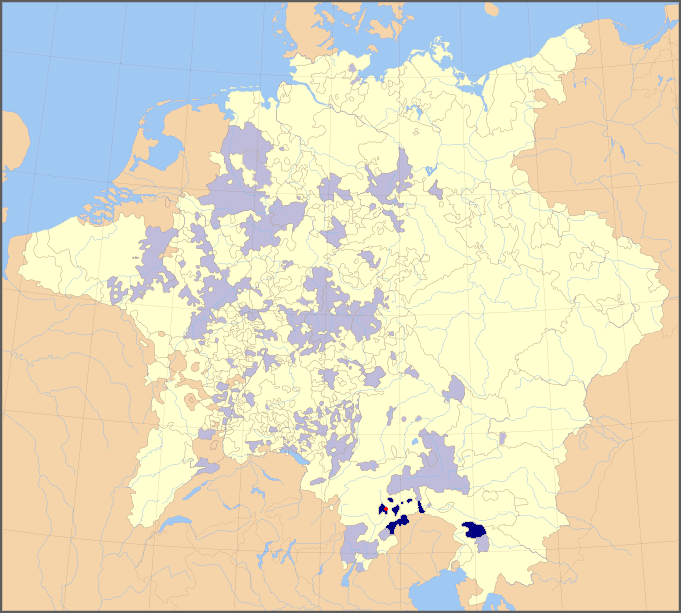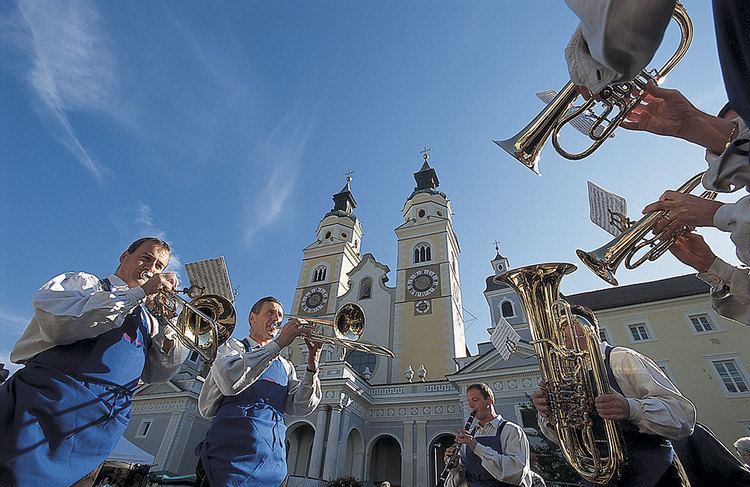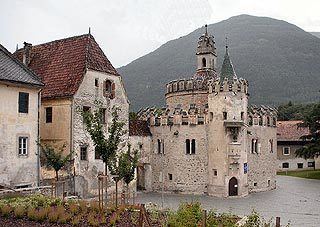Country Area 84.86 km2 Mayor Albert Purgstaller (SVP) | ||
 | ||
Region Trentino-Alto Adige/Sudtirol | ||
Map of Brixen
Brixen ( [ˈbrɪksn̩]; Italian: Bressanone [bressaˈnoːne]; Ladin: Porsenù or Persenon) is a town in South Tyrol in northern Italy, located about 40 kilometres (25 mi) north of Bolzano.
Contents
- Map of Brixen
- Brixen dolomiten marathon 2014 gopro running movie
- Geography
- Frazioni
- Origin
- Coat of arms
- Main sights
- Linguistic distribution
- Culture
- Notable people
- Transport
- Twin cities
- Sports
- References

Brixen dolomiten marathon 2014 gopro running movie
Geography

First mentioned in 901, Brixen is the third largest city and oldest town in the province, and the artistic and cultural capital of the valley. It is located at the confluence of the Eisack and Rienz rivers, 40 kilometres (25 mi) north of Bolzano and 45 kilometres (28 mi) south of the Brenner Pass, on the Italy-Austrian border. It is flanked on the eastern side by the Plose and Telegraph (Monte Telegrafo) mountains (2,504 m) and on the western side by the Königsanger (Monte Pascolo) (2,436 m) mountain.

Brixen is especially known as a major skiing resort (the Plose). Other activities include hydroelectric power, orchards, and vineyards.
Frazioni

Frazioni / incorporated villages: Afers (Eores), Albeins (Albes), Elvas, Gereuth, Karnol, Klerant (Cleran), Kranebitt (Costa d'Elvas), Mahr (La Mara), Mairdorf, Mellaun (Meluno), Pairdorf (Perara), Pinzagen (Pinzago), Plabach, Rutzenberg, St. Andrä (S.Andrea), St. Leonhard (S.Leonardo), Sarns (Sarnes), Tils (Tiles), Tötschling (Tecelinga), Tschötsch (Scezze), Untereben.
Origin
The area of Brixen has been settled since the Upper Paleolithic (8th millennium BC). Other settlements from the late Stone Age have been found and in 15 BC, the area was conquered by the Romans, who had their main settlement in the nearby Säben (Sabiona). They held it until around 590, when it was occupied by Bavarians.
The first mention of Brixen dates to 901 in a document issued by the King of Germany, Louis III the Child, in it a territory called Prihsna is assigned to Zacharias, bishop of Säben. As time passed, "Prihsna" turned into the current name of Brixen. The bishops moved here from Säben in 992, after the Cathedral had been finished.
In 1039, the Bishop of Brixen, Poppo, was elevated to Pope by emperor Henry III. However his reign lasted for only 23 days. Yet in the same century, Brixen became the seat of an independent ecclesiastical principate which, in the following years, struggled for existence against the neighbouring county of Tyrol. In 1115, a first line of walls encircling Brixen was completed.
The bishopric was secularized in 1803 and annexed by the Austrian Empire. Between 1851 and 1855, the Czech journalist and writer Karel Havlíček Borovský was exiled by the Austrian government to Brixen. After the end of World War I, Brixen was annexed by Italy.
Coat-of-arms
The oldest coat of arms dates back to 1297 with the lamb, known then from 1304 as a symbol of the lamb. On 13 November 1928, a shield with the city walls and a gate on the lawn in the upper half and the lamb in the lower was adopted. The emblem is a turned argent lamb with an or halo on a gules background; the right foreleg supports a flag with a gules cross. The emblem was granted in 1966.
Main sights
Outside the city is Rodeneck Castle, one of the most powerful of its time. It has precious frescoes from the early 13th century. Also important are Reifenstein Castle and Trostburg Castle in Waidbruck. In the latter lived the adventurer and minstrel Oswald von Wolkenstein.
Linguistic distribution
According to the 2011 census, the majority of the population speaks German as first language (72.82%). The remainder of the inhabitants speak Italian and Ladin as first languages, with percentages of 25.84% and 1.34%, respectively.
Culture
The rock band, Frei.Wild, has its origin in Brixen.
Notable people
Transport
Brixen has a railway station on the Brenner Railway, which connects the town to Verona and Innsbruck. It has an individual fare structure for public transport within the Tirol-Südtirol zone.
Italy
Germany/Austria/South Tyrol
(D for Germany, A for Austria)
On 11 December 2016, ÖBB will take over Deutsche Bahn's night trains. The Munich-Milan service will be withdrawn.
^ Train connects at Verona with ÖBB EuroNight Rome-Vienna: DB CityNightLine splits into two trains (first half couples with ÖBB Rome-Vienna and leaves for Vienna or Rome; second half continues to Munich or Milan). Vienna-Rome splits into two trains (first half continues to Rome or Vienna; second half couples with DB CityNightLine for Milan or Munich).
By road, the town has two exits on the Brenner Autobahn that connects Brixen to the Brenner Pass.
